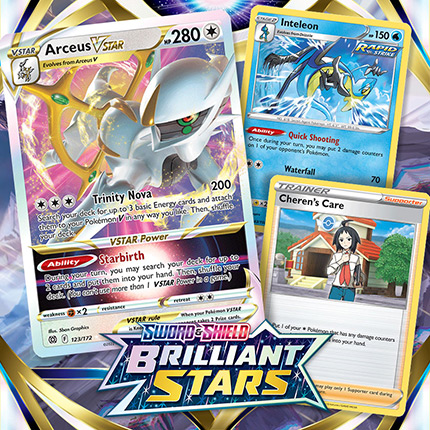The above list is based off one that Luke Morsa, aka Celio’s
Network, played in a recent tournament. The deck’s goal is to continuously
attack with Arceus VSTAR while making use of two strong Supporter cards, Boss’s Orders and Cheren’s Care, to swing the
Prize card trade in your favor. With Big Charm,
Arceus VSTAR has 310 HP, which even exceeds some Pokémon VMAX. If all goes
according to plan, you’ll use Boss’s Orders to take Prize cards or Cheren’s
Care to deny Prize cards each turn.
The Inteleon engine has made its way into many strong decks
since the release of Sword & Shield—Chilling Reign. Drizzile and Inteleon from Sword &
Shield were already here to smooth over general inconsistencies, and then
they were joined by another Inteleon
from Sword & Shield—Chilling Reign to fix awkward math with
its Quick Shooting Ability. Most importantly, each of these Pokémon gives up only
a single Prize card. Since the main attacker of this deck is a Pokémon VSTAR
and not a Pokémon VMAX, the opponent can only take two Prize cards at most
(excluding any shenanigans or multi-hit attacks).
Because of the Inteleon engine, several different Trainer
cards can be played. Being able to search for any Trainer card means you no
longer need to play additional copies of them to increase the probability of
drawing into a needed card naturally. The limiting count becomes the number you
might need in a game, with some insurance against unfavorable Prize cards. It
also allows you to play niche Item cards like Capacious Bucket, which is an option to get an Energy
through Shady Dealings.
Four Arceus V
and three Arceus VSTAR are a clear necessity because it’s the main
attacker. Moreover, it’s essential to attach an Energy to Arceus V on your
first turn to set up for Trinity Nova on the following turn. Early on, Melony
should be used as a bailout rather than the main course of action. Many decks
play a 4–4–2 Inteleon line, but I’ve decided to go with one less Drizzile. Instead,
I’ve opted for the fourth Level Ball over the fourth Drizzile to increase the
probability of finding Sobble on
the first turn. Because this deck rarely discards cards, and isn’t wholly
reliant on Shady Dealings because of Starbirth, I’ve found three Drizzile to be
enough. There’s one of each Inteleon so that both are options at any given
point.
Most Item slots are dedicated to Pokémon search cards. Quick Ball is the best search
card because it can find any Basic Pokémon, though most of the time you’ll
direct it towards Arceus V on the first turn. Level Ball is also maxed out because it can find both
Sobble and Drizzile. Next there is Evolution Incense,
which is the most efficient way to search the deck for Arceus VSTAR. Lastly, Ultra Ball serves to round out
the Ball Item count. It has the greatest cost but the greatest versatility.
The single Pal Pad
aims to add some additional value and flexibility. Other lists run three
Boss’s Orders and zero Pal Pad, though I’ve found the reshuffle to be quite
useful. The upside is that you can recycle Boss’s Orders, effectively playing
three, or any other Supporters that would be useful, such as Cheren’s Care or Marnie. The downside is that
drawing into Pal Pad does not draw you into the Supporter; you must search for
the Supporter with Shady Dealings.
Now looking at the Pokémon Tool cards, there is an even
split of Big Charm and Choice Belt. Big Charm’s purpose is to increase HP so
you can use Cheren’s Care on the following turn. It’s very important against
Mew VMAX, which aims to get a one-hit Knock Out on Arceus VSTAR. On the other
hand, Choice Belt increases Trinity Nova’s damage so it can Knock Out a Pokémon
V in a single attack. This is especially important when aiming to close out the
game with multiple Boss’s Orders on vulnerable Pokémon V.
The Supporter count is relatively straightforward, albeit
thin. Cheren’s Care, Boss’s Orders, and Marnie are absolute must-have
Supporters, which is why we have two copies of each. Once you get past the
first one or two turns, you should aim to play one of these each turn. Professor’s Research and Melony will
be necessary in relatively niche situations, and therefore only have one copy.
The final component of the deck is its Stadium cards. There is one rule in
today’s Standard format: If you’re not playing Mew VMAX, you play Path to the Peak. Because this
deck isn’t Mew VMAX, there are three Path to the Peak in the list. It’s true
that you cannot use Starbirth while Path to the Peak is in play, but it’s more
important to have a way to shut down Genesect V‘s
Fusion Strike System. Considering that Starbirth is a one-time use
Ability anyway, there will certainly be a point in the game where no Stadium or
a different Stadium is in play.
Arceus VSTAR is a relatively easy deck to play, making it
great for beginners to pick up in addition to being an all-around great deck.
Your goal on the first turn is to put an Arceus V into play and attach an
Energy. With this setup, you’re ready to attack with Trinity Nova on the
following turn. You should aim to find one or two Sobble as well, if possible.
Against some decks such as Mew VMAX, Arceus V can be vulnerable in the Active
Spot. When going second, consider starting with Sobble and putting Arceus V on
the Bench. You’re most vulnerable on the first turn.
On turn two, do everything you can to attack with Trinity
Nova. It’s all right to use Starbirth this early to search for the necessary
cards, such as Double Turbo Energy to power up Arceus VSTAR and Scoop Up Net to move a Sobble or
Drizzile from the Active Spot. Another important piece is to get an Arceus V on
the Bench that you can load up with Energy via Trinity Nova. Keep in mind that
you don’t need to attach all three Energy. Sometimes, you’ll only want to
attach one and leave some Energy in the deck for future use. So long as you
have Double Turbo Energy in hand (or can pick one up with Cheren’s Care), you
only need one Energy on the Benched Arceus V.
On the following turns, you’ll then want to play Marnie,
Cheren’s Care, or Boss’s Orders depending on what the opponent does. If your opponent
hits your Arceus VSTAR, nine times out of ten you should play Cheren’s Care to
return the damaged Arceus VSTAR to your hand, evolve your Benched Arceus V into
Arceus VSTAR, put the Arceus V you returned to your hand back on your Bench,
and attack with Trinity Nova using the new Arceus VSTAR. In these instances,
you’ve essentially gained a free turn.
If the opponent instead Knocks Out Arceus VSTAR or a
different Pokémon on your Bench with Boss’s Orders, you’ll want to do something
different. In these situations, consider whether Boss’s Orders or Marnie will
disrupt the opponent more. Do they have a large hand size? Is there a
vulnerable Pokémon on their Bench with Energy attached, such as another Arceus
V or Mew V? These are
the questions you should ask yourself. Sometimes, it may be best to not do
either and simply attack into the opponent’s Active Pokémon. If that’s their
only attacker and they have a small hand, there’s no need to do anything other
than put another Arceus V on your Bench and use Trinity Nova.
In the middle of the game, you’ll want to consider attacking
with Inteleon from Sword & Shield. With this maneuver, you can hope
to force the “seven-Prize game.” This means the opponent will take their Prize
cards in such a manner that you force them to take more than they need to win. For
example, when the opponent has a single Prize card remaining and Knocks Out an
Arceus VSTAR to win. That is a much harder task than Knocking Out a Sobble.
The seven-Prize game can most commonly be employed against
decks with few or zero ways to switch your Active Pokémon. Rapid Strike Malamar is a good
example; it usually plays zero Boss’s Orders and few Pokémon Catcher, if any. In this matchup, you should
attack with Inteleon when the opponent has an even number of Prize cards
remaining. Then you can continuously attack with Arceus VSTAR. If the opponent
has four Prize cards remaining, by interjecting with an attack with Inteleon,
you’ve given yourself three turns of attacking, assuming the opponent scores a
Knock Out each turn. With just Arceus VSTAR, then you only have two attacks.
Arceus VSTAR is incredibly strong in the current Standard format
meta. Because of its high HP and the inclusion of Path to the Peak, Arceus
VSTAR rivals the other best deck, Mew VMAX. If you’re looking for a dynamic
deck to play, look no further than the Mythical Pokémon Arceus VSTAR and its
sidekick Inteleon.
About the Writer

Xander Pero
Xander Pero is a contributing writer for Pokemon.com. He was an avid fan until discovering sanctioned tournaments in 2009. He formerly traveled often for the Top 16 circuit, but now spends his time focusing on university, where he studies industrial engineering. You can find him at various tournaments, as well as on Twitter at @xanderpero.

Source: Pokemon



